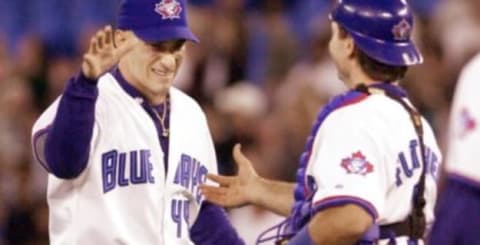Blue Jays: All-Time Drafted and Developed Relievers

Fans will get most excited about the positional players and the starting rotation, but part of drafting is completing an entire team. In this article I’ll take a look at the top drafted and developed Blue Jays to come out of the bullpen.
It seems that bullpen arms have become more of a journeymen type pitcher, and rarely perform for a while for the teams that drafted them. In the Blue Jays history, they have managed to develop a couple solid closers, converted some starters into relievers, and just had some straight up middle relief arms.
If you missed the top drafted and developed players and starting pitchers click on the links below.
Top Positional Players – Drafted and Developed
Top Starting Pitchers – Drafted and Developed

#5 Aaron Loup
Would it shock you if you I told that the bullpen pitcher with one of the Blue Jays best career ERAs for a player that was drafted by the team was Aaron Loup? Well, it is true.
Toronto selected Loup in the ninth round of the 2009 MLB Draft from Tulane University after playing two seasons there with a 5.12 ERA. Throughout the system, Loup was never a thought of as a top end prospect, but he continued to progress year after year. After being drafted, Loup reported to the teams Gulf Coast Rookie team where he finished the season pitching 16.1 IP with 6:1 strikeout to walk ratio and 3.86 ERA.
Over the next couple of years, Loup continued to climb; he would spend a full season at each level playing in Lansing, Dunedin and finally New Hampshire in 2012. Outside of five starts he had in Class A Lansing, Loup was always a reliever. In 2012, after throwing 45.1 IP to a 2.78 ERA and a 3:1 strikeout to walk ratio he was called up to the Blue Jays skipping AAA baseball.
On July 14, 2012, Loup would make his debut and retired all six batters he faced to help the Blue Jays defeat the Cleveland Indians. Loup would remain on the Blue Jays roster for the remainder of the season and allow runs in only five of his 33 appearances, including failing to allow a run in his final 11 appearances of the season. Loup finished the campaign with a 2.64 ERA, 0.91 WHIP and had 21 strikeouts to 2 walks over 30.2 IP.
Outside of a couple rehab appearances in the minors, Loup would remain in the big leagues for the remainder of his tenure with the Blue Jays. He would twice reach the 70 game appearance mark (2014 and 2017) and collected a total of six saves over his tenure. Loup’s Blue Jay career total is a 12-20 record with a 3.47 ERA and 1.27 WHIP.
During the 2018 Trade Deadline he was traded to the Philadelphia Phillies for Jacob Waguespack. Due to injuries, Loup had been able to pitch just 7.1 innings since being traded out of Toronto.

#4 Mike Timlin
Picking up the save in the Blue Jays first ever World Series win should be enough on its on to get you on the list, but Mike Timlin did more than just that.
The Blue Jays selected Timlin in the fifth round out of Southwestern University during the 1987 MLB Draft. He initially began his professional career as a starting pitcher and even made 22 starts in 1988 with the Myrtle Beach Blue Jays, however he was eventually converted to the bullpen and really started to take off.
During the 1990 season, Timlin started the season in Advanced A Dunedin as the team’s closing pitcher. He would collect seven wins and 22 saves to a 1.43 ERA and be moved up to AA Knoxville to finish the season. He would become the team’s closer as soon as he arrived and collected eight saves to a 1.73 ERA.
After having a superb 1990 minor league season, Timlin would break camp in 1991 with the big club and pitch in 63 games that season. Out of the bullpen, Timlin would collected 11 wins and three saves with a 3.16 ERA, which helped him finish sixth in Rookie of the Year voting. As said before, Timlin’s most famous Blue Jay performance was getting Otis Nixon out in Game 6 of the World Series to win their first ever championship in 1992.
Timlin would pitch for the Blue Jays until 1997 and became the closer in 1996. During that season he collected 31 saves, however, the following season with the Blue Jays 17 games back of the AL East, he was traded along with Paul Spoljaric to the Seattle Mariners for a young player name Jose Cruz Jr.
Timlin finished his seven-year Toronto career with 23 wins and 52 saves while posting a 3.62 ERA.

#3 Brett Cecil
There is two different stories for Brett Cecil, one being the average big league starter that had a 28-26 record with 4.77 ERA, as well as an All-Star relief pitcher who had a 3.05 ERA out of the bullpen.
In 2007, the Blue Jays used their compensation pick in the supplemental round for losing Justin Speier on Brett Cecil. Cecil was coming off two seasons pitching at the University of Maryland, as well as playing a season in the Cal Ripkin Collegiate Baseball League where he threw the only complete game no hitter in the league history.
After being drafted, Cecil reported to Auburn for Short-Season A baseball and he performed quite well. He pitched just shy of 50 innings over 13 starts and held a minuscule 1.26 ERA and 0.95 WHIP. In 2008, Cecil played his first full professional season and climbed the ranks from Dunedin, all the way to AAA Syracuse.
In 2009, less than two years after being drafted, Cecil started his first career game on May 5 where he pitched six innings, allowing just one earned run on six strikeouts. Cecil would have an up and down career over the next few seasons as a starting pitcher winning 15 games in 2010, but eventually found himself back in the minors by 2012 after posting a 5.72 ERA over nine starts and 32 innings. Cecil was converted to a relief pitcher and recalled in September. He would struggle during his first stint in the Blue Jays bullpen posting an identical 5.72 ERA in September.
Cecil’s career would turn around the following season when he broke camp as a full-time relief pitcher in 2013. Cecil would pick up five wins out of the bullpen and it would be the first of three consecutive seasons of sub 3.00 ERA and over 60 appearances; which also saw him get selected to the 2013 All-Star Game.
Cecil was able to been identified as one of the most reliable left handed pitchers out of the bullpen in the major leagues and cashed in on his success. After eight years on the Blue Jays, Cecil signed as a free agent with the St. Louis Cardinals on a four year deal worth $30.5 million.
Cecil finished his Blue Jays career with 44 wins, 12 saves and a 4.29 ERA.

#2 – Casey Janssen
Similar to Brett Cecil, Casey Janssen originally came up with the Blue Jays as a starting pitcher, however, excelled out of the bullpen and became the team’s closing pitcher for three seasons.
The Blue Jays took Janssen in the fourth round of the 2004 MLB draft out of UCLA after coming off a 10-4 senior season in college with a 3.16 ERA. Immediately after being drafted Janssen was assigned to Auburn of Short-Season A baseball and was developed as a starting pitcher through the minors. In 2005, which was his first full year of professional baseball, Janssen jumped three levels finishing the season in New Hampshire.
Janssen was able to jump to the majors in less than two years as on April 27, 2006 he made his major league debut against the Baltimore Orioles. Janssen would make 17 starts that season and post a 6-10 record with a 5.07 ERA, but the club would move him almost full-time to the bullpen after that. In his first full season with the Blue Jays in 2007 he would make 70 appearances out of the bullpen and collect six saves with a 2.35 ERA. Things were looking up for him, however, during Spring Training in 2008 he suffered a torn labrum and would miss the entire season.
It would take Janssen a couple seasons to rebound from the injury and in 2010 he seemed to finally be fully recovered. He went on a five year stretch where he had a sub 3.95 ERA in each year and became the closer in three of those years. During that stretch Janssen record 83 saves and had a 2.99 ERA. He finished his Blue Jays tenure with 29 wins and 90 saves in total, which puts him fifth all-time for Blue Jays closers.
Janssen would leave after the 2014 season in free agency and signed with the Washington Nationals.

#1 – Billy Koch
Billy Koch played only three seasons for the Blue Jays, but he did enough in that time to claim the top spot on our list.
More from Jays Journal
- Matt Chapman has been exactly what the Blue Jays needed
- Blue Jays: The goalposts are moving in the right direction
- Single-A Dunedin Blue Jays advance to the Championship Series
- Blue Jays: Comparisons for Alek Manoah’s Second Season
- Blue Jays: Adam Cimber, the unlikely decision King
In 1996, the Blue Jays held the fourth overall pick and they used it to draft Koch out of Clemson University. Koch impressed immediately through the minors as he was able to consistently throw 100 mph. The team placed him in Advanced A baseball right out of the draft where he made three starts there collecting 20 strikeouts to just three walks. In his second professional season, after posting a 14-7 record with a 3.75 ERA he was moved all the way up to AAA Syracuse where he finished out the season.
In 1999, with just 35 minor league games to his name he came out of the bullpen on May 5 to pitch 2.2 no hit innings. Koch was able to jump to the majors less than two years after being drafted. He was moved into the closer’s role that season and recorded 31 saves with a 3.39 ERA. His 57 strikeouts in 64 innings helped him receive votes for Rookie of the Year where he finished seventh in voting.
Koch remained the closing pitcher for the next two seasons, recording 33 and 36 saves respectfully. He finished his three seasons with a total of 100 saves which rank him fourth all-time for Blue Jays closer’s behind Roberto Osuna, Duane Ward and Tom Henke.
The Blue Jays finished their 2001 season two games below .500, had new management coming and were looking to make some changes. Koch was traded to the Oakland Athletics in exchange for Eric Hinske and Justin Miller.
Next. New Draft, New MiLB. dark
Was there someone you think should have been on the list? Who do you think was the best of the group?